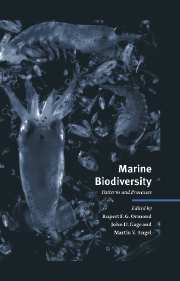Book contents
- Frontmatter
- Contents
- List of contributors
- Foreword: The value of diversity
- 1 Marine biodiversity in its global context
- 2 Gradients in marine biodiversity
- 3 Pelagic biodiversity
- 4 Biological diversity in oceanic macrozooplankton: More than counting species
- 5 Large-scale patterns of species diversity in the deep-sea benthos
- 6 Diversity, latitude and time: Patterns in the shallow sea
- 7 High benthic species diversity in deep-sea sediments: The importance of hydrodynamics
- 8 Diversity and structure of tropical Indo-Pacific benthic communities: Relation to regimes of nutrient input
- 9 Why are coral reef communities so diverse?
- 10 The biodiversity of coral reef fishes
- 11 The historical component of marine taxonomic diversity gradients
- 12 Population genetics and demography of marine species
- 13 Discovering unrecognised diversity among marine molluscs
- 14 Ecosystem function at low biodiversity – the Baltic example
- 15 Land–seascape diversity of the USA East Coast coastal zone with particular reference to estuaries
- 16 The development of mariculture and its implications for biodiversity
- 17 Protecting marine biodiversity and integrated coastal zone management
- 18 Conserving biodiversity in North-East Atlantic marine ecosystems
- Author index
- Species index
- Subject index
6 - Diversity, latitude and time: Patterns in the shallow sea
Published online by Cambridge University Press: 04 August 2010
- Frontmatter
- Contents
- List of contributors
- Foreword: The value of diversity
- 1 Marine biodiversity in its global context
- 2 Gradients in marine biodiversity
- 3 Pelagic biodiversity
- 4 Biological diversity in oceanic macrozooplankton: More than counting species
- 5 Large-scale patterns of species diversity in the deep-sea benthos
- 6 Diversity, latitude and time: Patterns in the shallow sea
- 7 High benthic species diversity in deep-sea sediments: The importance of hydrodynamics
- 8 Diversity and structure of tropical Indo-Pacific benthic communities: Relation to regimes of nutrient input
- 9 Why are coral reef communities so diverse?
- 10 The biodiversity of coral reef fishes
- 11 The historical component of marine taxonomic diversity gradients
- 12 Population genetics and demography of marine species
- 13 Discovering unrecognised diversity among marine molluscs
- 14 Ecosystem function at low biodiversity – the Baltic example
- 15 Land–seascape diversity of the USA East Coast coastal zone with particular reference to estuaries
- 16 The development of mariculture and its implications for biodiversity
- 17 Protecting marine biodiversity and integrated coastal zone management
- 18 Conserving biodiversity in North-East Atlantic marine ecosystems
- Author index
- Species index
- Subject index
Summary
Abstract
The latitudinal cline in diversity is a well established, though poorly understood, feature of terrestrial communities and although it is often assumed that a similar cline is to be found in the sea, the evidence for this is still equivocal. Attempts to develop an overall picture of diversity in the sea are made difficult by the small number of key studies, the varied sampling protocols employed in these studies, the different measures of diversity utilised and the varying levels of taxonomic resolution. Nevertheless, there is clear evidence for greater species richness in the tropics for several shallow-water taxa that depend on calcareous skeletons, including gastropod and bivalve molluscs, foraminifera and hermatypic corals. There is also an increasing body of evidence for a latitudinal diversity cline in the deep sea, at least in the northern hemisphere. However, any cline in species richness in the northern hemisphere will, in part, be a necessary consequence of the depauperate Arctic fauna and the intense species richness of the Indo-West Pacific. The Southern Ocean is now known to support a rich and diverse shallow-water benthic fauna, the striking contrast to the Arctic being the result of a very different tectonic and evolutionary history. Whereas the Arctic marine system is very young and still being colonised, the Southern Ocean marine fauna has essentially evolved in situ, and has been influenced by a dynamic glacial and climatic history.
- Type
- Chapter
- Information
- Marine BiodiversityPatterns and Processes, pp. 122 - 147Publisher: Cambridge University PressPrint publication year: 1997
- 52
- Cited by



